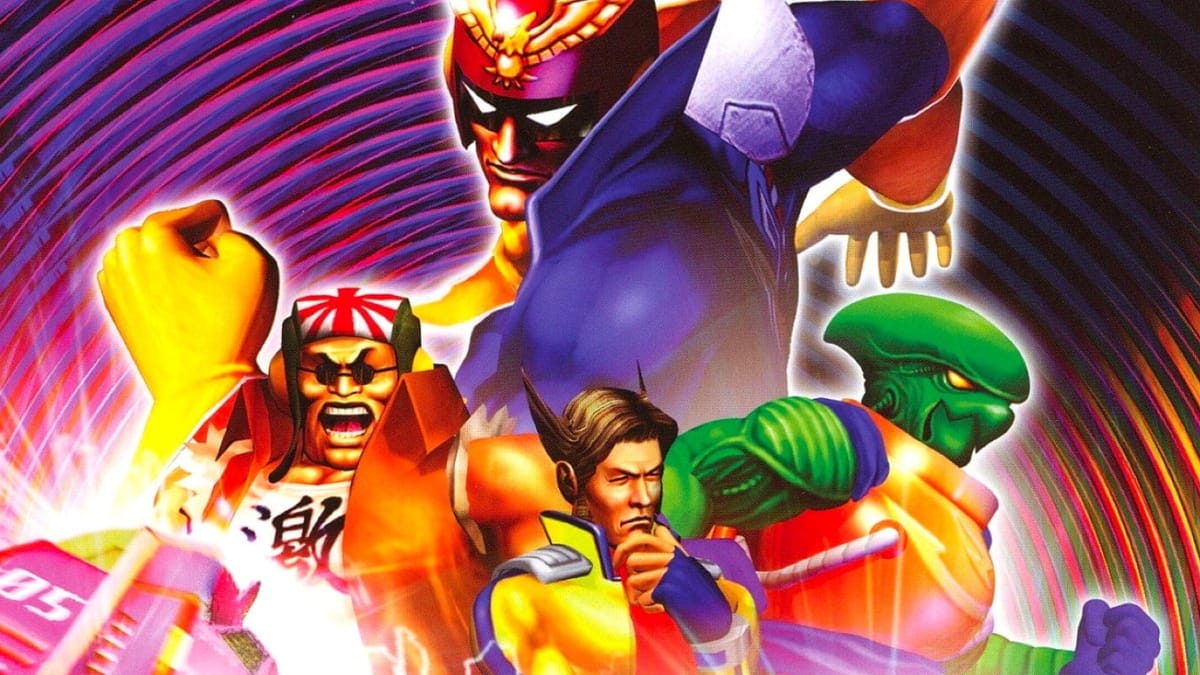
The Nintendo Gamecube – the little purple prism that could...or couldn't. While the system's middling performance was a rough patch for The Big N, many young gamers grew up cherishing its library of games. But do they hold up today? Join Anthony on his quest to find out as he reviews every classic title offered on Switch 2's Nintendo Classics service.
The very concept of F-Zero GX would’ve been unthinkable in the ’90s – a Nintendo and Sega collaboration, helmed by the latter to develop a new entry in a legacy racing franchise? How scandalous! Such traitorous thinking was strictly forbidden in the ongoing Console Wars, punishable by full-length playthroughs of Bebe’s Kids and Shaq Fu in solitary confinement. What’s next: the Dreamcast would die an untimely death, and Sonic the Hedgehog would find a new home on Nintendo GameCube? Haw!
Yeah, about that…
Turns out, behind the bitter marketing feuds and sensationalist media coverage, there weren’t any hard feelings; in fact, this prophetic 1999 interview between Shigeru Miyamoto and future F-Zero GX producer Toshihiro Nagoshi displayed not merely a mutual respect, but a shared interest in how arcade racers come to life with replica set-ups and force-feedback, simulating the red-hot thrill of actual racing. Paired with their desire to work together, such reverence undoubtedly paved the road for GX’s arcade counterpart in F-Zero AX, the ambassador for the “Triforce” arcade collaboration between Nintendo, Sega, and Namco.
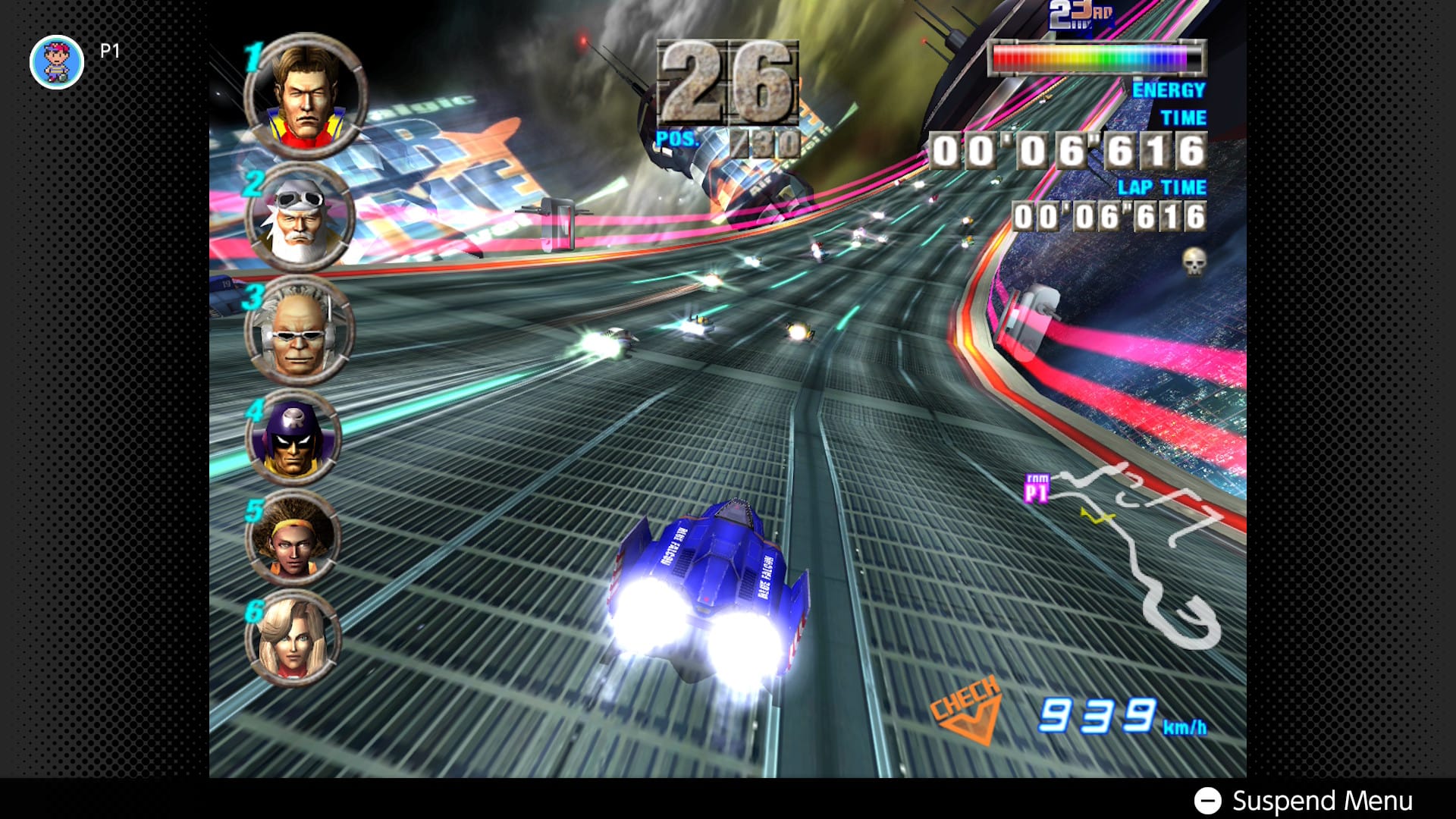
It was a match made in heaven: Nagoshi revered the original F-Zero, citing the SNES game as an inspiration behind Daytona USA: his own breakout racer and directorial debut. Developed by Super Monkey Ball producer Amusement Vision, F-Zero GX shares much DNA with its banana-crazy cousins in its navigable boards, suspended at sky-high altitudes and demanding meticulous precision at every turn. Yet, unlike Monkey Ball, F-Zero is no solo balancing act – with thirty racers battling for supremacy and a health meter rapidly chipped away from crashes, bombs, and the very courses themselves, GX is a true daredevil sport only the future could provide.
F-Zero GX is unapologetic in its difficulty – from its multitude of racing cups to its infamous Story Mode, it was a different breed from such Nintendo contemporaries as Mario Kart: Double Dash!! and Kirby Air Ride. Whereas those games prided themselves on accessibility and out-of-the-box concepts, F-Zero GX is purely in it for the thrill of the race. It is blindingly, blisteringly fast – loop-de-loops, curves, and tubes tossing the player every which way like a runaway soda bottle rocket. Death is a common occurrence, not the least in the controller-throwing rage of plunging off-course. It’s not long before your lives begin depleting – a ticking clock for the end of your F-Zero career.
It is a game not meant for the faint of heart, yet revisiting it now, not since the fall after it launched, I believe – I’m reminded of why it’s held in such high regard. F-Zero GX just feels incredible to play, its mind-melting speed balanced with constant push and pull. Boosting, for instance, can’t be pulled off liberally – your energy’s depleted with every press, and careless use is punished by killer crashes and fatal fall-outs. Hotshot racers quickly learn to neutralize health depletion by boosting over life-restoring pits, while the expert carefully memorizes each track’s layout to exploit corners and shortcuts. From practice to mastery, these deadly roller-coasters are conquered one by one, all for the sake of chasing after that light-speed dopamine.
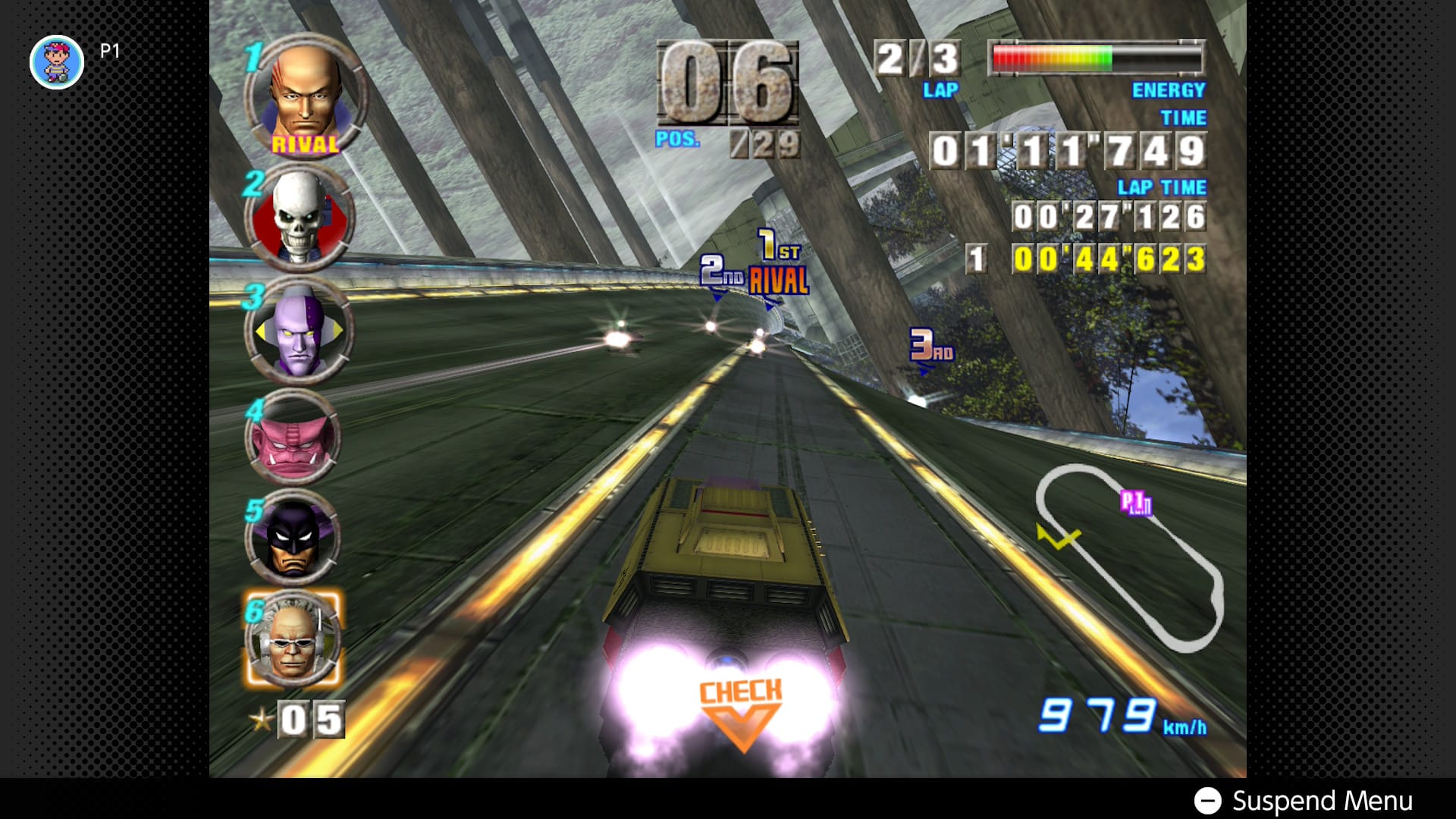
“Deadly”, of course, is hardly an adjective reserved for the courses themselves. With twenty-nine other racers busy swapping paint, there’s only one answer to level the playing field: sabotage. With both Side and Spin Attacks at your vehicle’s disposal, there are endless opportunities to thin out the competition. Is there a rival threatening your winning streak? Need some crowd control to squeeze through a tight space? Just knock ‘em out of the race! Easier said than done – both attacks require careful application lest you lose momentum, but there’s nothing more devilishly delightful to, shall we say, deliver an “early retirement”. (And hey, got a problem? Take it up with the league – totally legal!)
Much like the rest of the series, the beginner’s trick to F-Zero GX is recognizing when to curb your speed – a harsh lesson the courses are all too happy to remind overeager racers with tight turns (Mute City: Serial Gaps and Casino Palace: Double Branches) and bottomless pits (Sand Ocean: Lateral Shift). With such an expansive cast, each track can be approached as a puzzle in navigating around each vehicle’s strengths and weaknesses, deducing the ever-elusive balance of minimized and maximized speed. (Only the dizzying Fire Field: Cylinder Knot eludes praise – the “tube” concept’s especially novel for a futuristic setting, but its dependence on Dash Zone memorization is ill-conceived for its topsy-turvy design, leaving discombobulated racers scrambling for much-needed boosts before falling to their fiery demise.)
Knowing when to boost, mastering the art of rocket-launch handling -- triumphing over the insurmountable ordeal that is F-Zero GX is absolution. Just ask the enduring community that’s the F-Zero GX playerbase, with two decades of dedication to their name as they shave off record after record. As someone who can barely overcome Standard difficulty, I humble myself before the sheer wizardry displayed above: merely watch how Captain Falcon lives up to his namesake, soaring above the streets of Mute City and gliding past shortcuts at supersonic speeds. Every lesson in the F-Zero rulebook is immediately tossed aside, constant boosts and reckless bomb plowing all elaborate steps for pursuing the world record, paving the road for the glorious end that is his suicide finish. Surely, such an impossible feat moved even the racing gods, seeing fit to revive him amidst his final hour.
Does F-Zero GX’s claims of speeds at 2000 km/hour pass muster? That’s a question for the mathematicians to deduce, but mother of God, such videos may well be living proof.
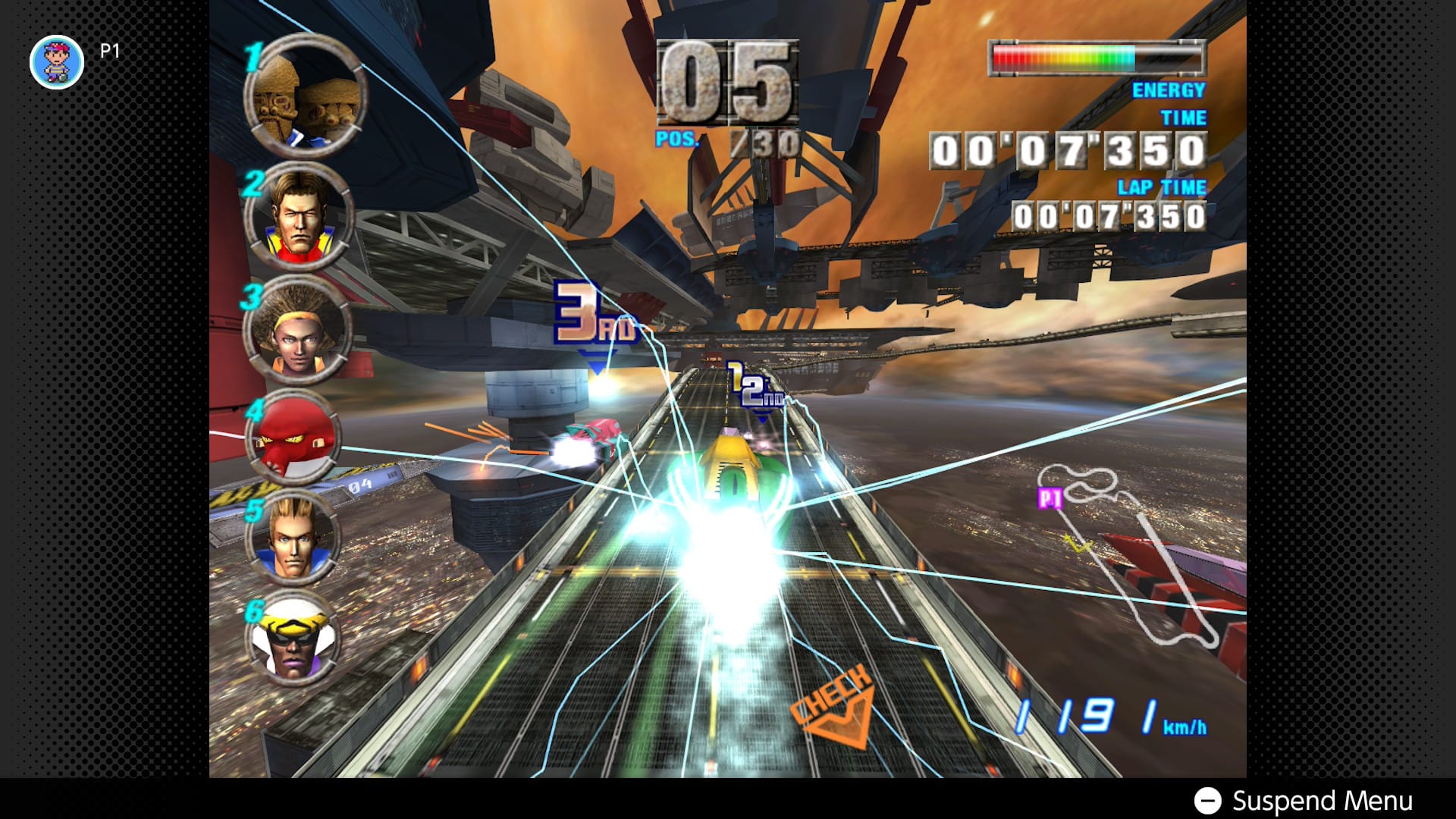
And how good it still looks! Whereas N64 predecessor F-Zero X wisely sacrificed detail for framerate, the GameCube’s graphical prowess can finally juggle both: from Port Town’s bustling airspace to Sand Ocean’s sea of ancient tech and carnivorous ecology, it decorates each course with just enough worldbuilding that never distracts from the cutthroat racing. Any rare moments where F-Zero GX shows off are always in service to the gameplay; namely, Cosmic Terminal’s mile-high drop, awing even today with the thrill of plummeting down, down, down a cavernous space station, tasking the player with landing on any three branching paths. (There’s only one visual weakness in the emulation: the character portraits are all pixelated without the CRT filter. Ack!)
F-Zero GX thrives in its ambition. The customization garage lets everyone design their futuristic racecar. (Albeit with notoriously inaccurate part ratings – consult a guide!) Whenever the soundtrack’s not blasting iron-pumping techno, it’s producing a wide library of genres in ensuring each character gets their own elaborate theme song, many featuring cheesy lyrics. The wealth of context finally breathed life into the futuristic universe of F-Zero, not the least in the game’s biggest point of contention: Story Mode.
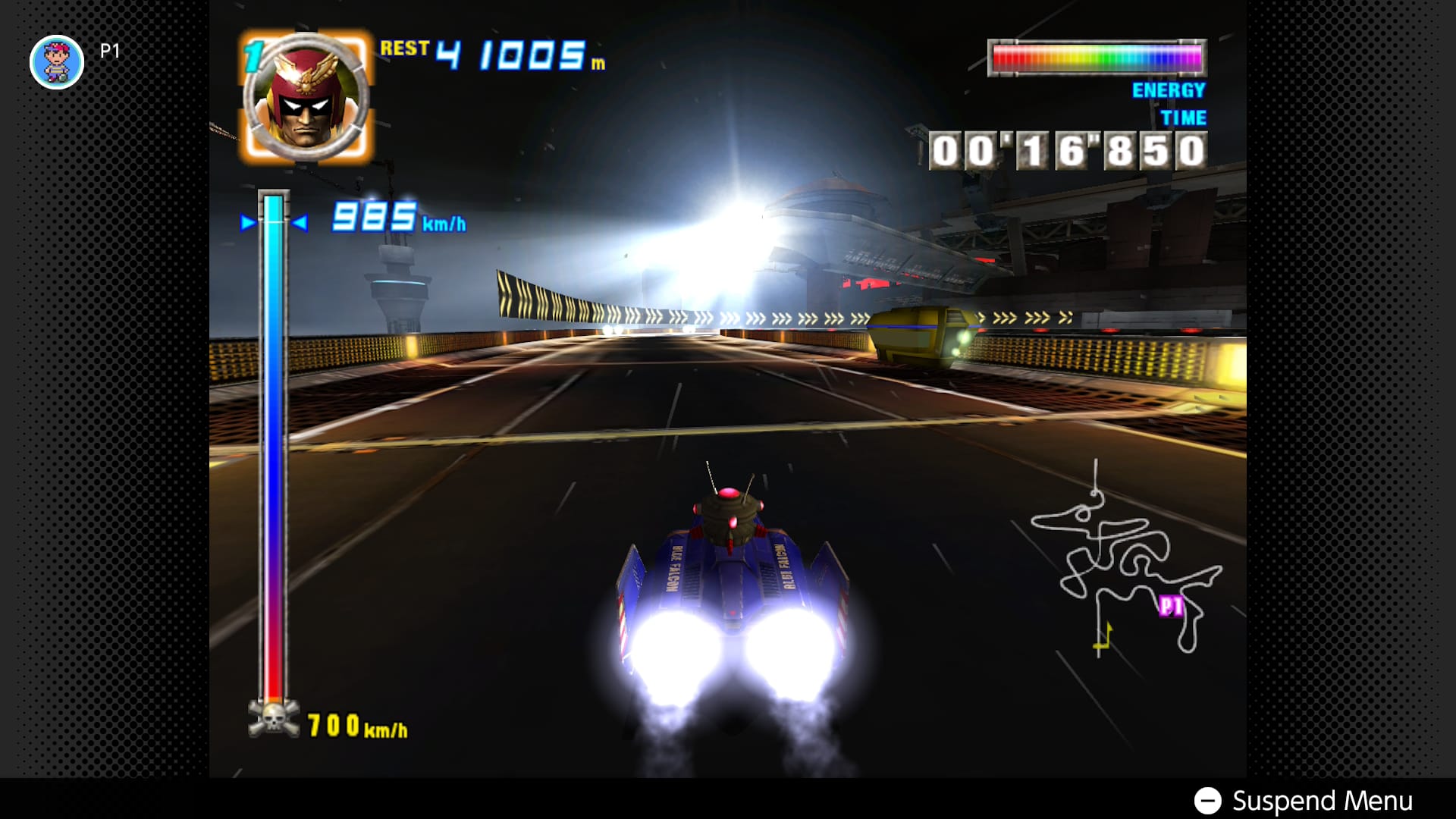
Often serving as the racing game ambassador in teaching newcomers the ropes, while the nine chapters do highlight the game’s mechanics one by one, F-Zero GX deviously frames its mechanics within Herculean tasks. For instance, you’ll naturally need to learn drifting to avoid crashing – a common F-Zero mistake – yet Chapter 6’s idea of an extreme training regimen straps your vehicle with a bomb that explodes if you fall under a certain speed threshold; in other words, crashing means instant death. Um, yikes.
Some appreciate the challenge; others, namely newcomers finding their bearings in unfamiliar waters, find it a stumbling block and judge the game from there. While the meat of F-Zero GX lies in its racing, it’s easy to sympathize given how Story Mode’s placed front-and-center as the star attraction. To call it poorly designed would be folly – there’s little more satisfaction than overcoming most any chapter’s rigors -- yet that Amusement Vision placed scarce footholds for all but the hardcore to grasp limits the game’s appeal.
That, and the actual story itself, is, well, crummy. Blending F-Zero’s signature racing within comic book sci-fi isn’t necessarily the issue – it’s hardly the most interesting narrative base, so they best serve as contextual backdrops no matter how goofy – yet everything from the awkward motion-capture to the lousy, poorly-mixed voice acting was laughable even in 2003. Merely observe how it bleeds into the post-cup “interviews”: all comically abrupt, their one-sentence answers ranging from stilted dialogue, overacted non-sequiturs, indecipherable alien filters, and, uh, immensely problematic stereotypes. (South Park-esque Chinese accents? Boy, how did that slip past Nintendo’s censors?) Fleshing out F-Zero’s 40-pilot roster is an enticing concept, but they never quite come alive.
That is, unless you’re into absurdism by way of Adult Swim’s late-night television. Describing the pantomime fever dreams that are the unlockable character videos would be an impossible task, overwhelming the viewer with tongue-in-cheek dissonance in everything from laundromat escapades to impromptu dance sessions. This is done purposefully: having cleared the improbable ordeal that is Master Cup, what better way to reward the player for their hard-won efforts by confusing them with CGI anarchy? They’re proverbial hats upon hats; all stacked together at the player’s expense.
Still, F-Zero GX’s contextual failings are all but momentary lapses – sparse brevities never threatening to bring it crashing back down to earth. Nay, what threatens to ground F-Zero GX’s orbit is a more modern mishap: input lag. Much ado has been made over how that’s plagued the Nintendo Classics service, and with Switch 2’s GameCube re-releases offering particularly egregious examples, it’s unfortunate that F-Zero GX suffers the worst of the lot. It’s bad enough the default controls are incomprehensible on their own – the spin attacks should be on the shoulder trigger, not the face buttons! – but at least those can be remapped; alas, the in-game calibration feature can only do so much for twitchy controls, leaving us with hover cars constantly skidding on invisible ice.
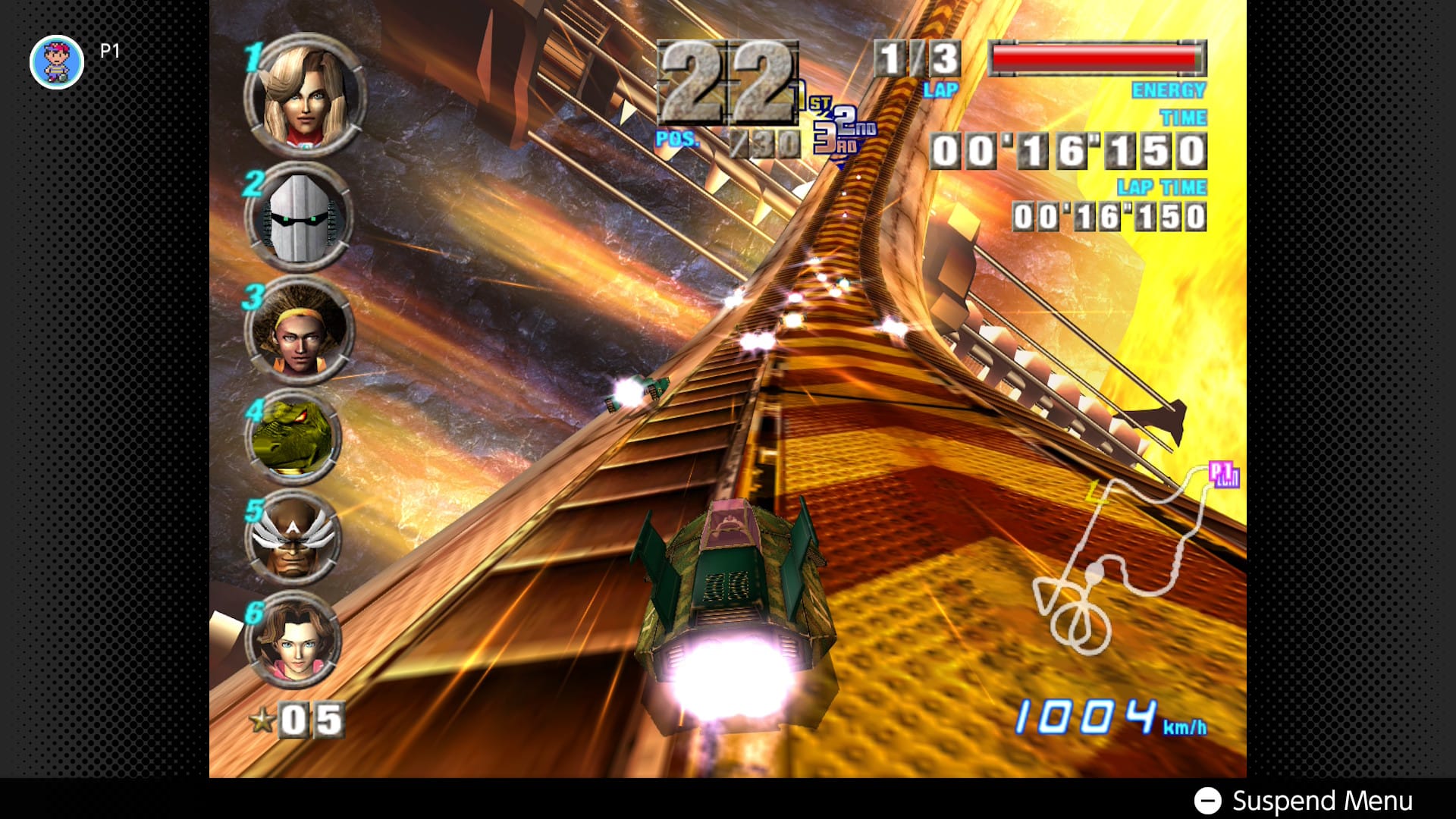
For an ultra-sensitive game such as this, this proves a fatal combination, with crashes and fall-outs occurring far more than average. Having conducted multiple tests with both Switch 2’s emulation and the original hardware, the problem lies squarely within the control stick’s dead zone – the level of pushing distance required for the game to recognize movement. The Switch 2 ignites this dead zone into hyper drive, registering max input for any movement no matter how slight. Poor grip vehicles taking the worst of it – one might say the Night Thunder would control exactly as you’d expect from a 98-year-old man behind the wheel, one who’d unwittingly poured butter on the controls.
Chapter 5 of Story Mode is the easiest point of comparison: this frantic one-minute time squeezes Captain Falcon in a self-destructing tunnel, wherein his Blue Falcon must expertly worm through every crevice to escape. It’s no cakewalk in either version, yet the differences were immediate: whereas I smoothly glided through most every crevice on GameCube, my machine kept sliding every which way, skidding outside my intended directions and slamming poor Falcon into each closing gate, sealing his fate again and again.
To be clear, this isn’t to say it’s impossible: to the newcomer or those who haven’t played F-Zero GX in years and years (read: me), it’s nothing some good ol’ fashioned practice can’t overcome. Let it be noted that while Story Mode gave me some real grief as a kid, I was able to clear most chapters on Switch 2 with some trial and error. But for dedicated fans who’ve committed the game to muscle memory, it may well be an unplayable turn-off. Put simply, I should not be taking fifty attempts to do a Mute City: Serial Gaps race on Novice. F-Zero GX is already hard enough!
This would be disappointing enough on its own, but alas, that’s not even the worst of it: there’s a nasty save glitch going around, one apparently exclusive to F-Zero GX. For whatever reason, upon being booted up, the game may randomly claim there’s no data in the virtual memory card – even if the player’s sunk substantial time into it prior. Only save states will work around this (were you vigilant in saving them), and even then, it won’t register any new saves made from that state. As seen above, this didn’t just happen to me – it’s been reported across the community. For the time being, you’ll want to preserve save states every time you play.
Regardless, it’s simply not in an acceptable state. While there’s little doubt Nintendo will get around to this save issue, doubt remains on input lag -– F-Zero X faithful point out there’s still emulation issues on Nintendo Classics years after the fact, and Nintendo may simply not see such trifles as a priority. There’s still a fantastic game here, arguably one of GameCube’s best, and all the more reason it deserves more authentic emulation.
Such is the cards F-Zero has been dealt for over two decades -- while F-Zero GX proved itself a modest success (producer Nagoshi claimed it sold 1.5 million copies) and got the ball rolling for future Nintendo/Sega collaborations, it wasn’t enough to secure the series’ future. Be it F-Zero’s signature difficulty or the failure of the F-Zero GP Legend anime, GX’s flag-bearing for a multi-media effort petered out in a last-place finish. As Nintendo prioritized the more family-friendly Mario Kart franchise, the Blue Falcon languished in the garage, taken out only for test runs around Smash Bros. battlefields.
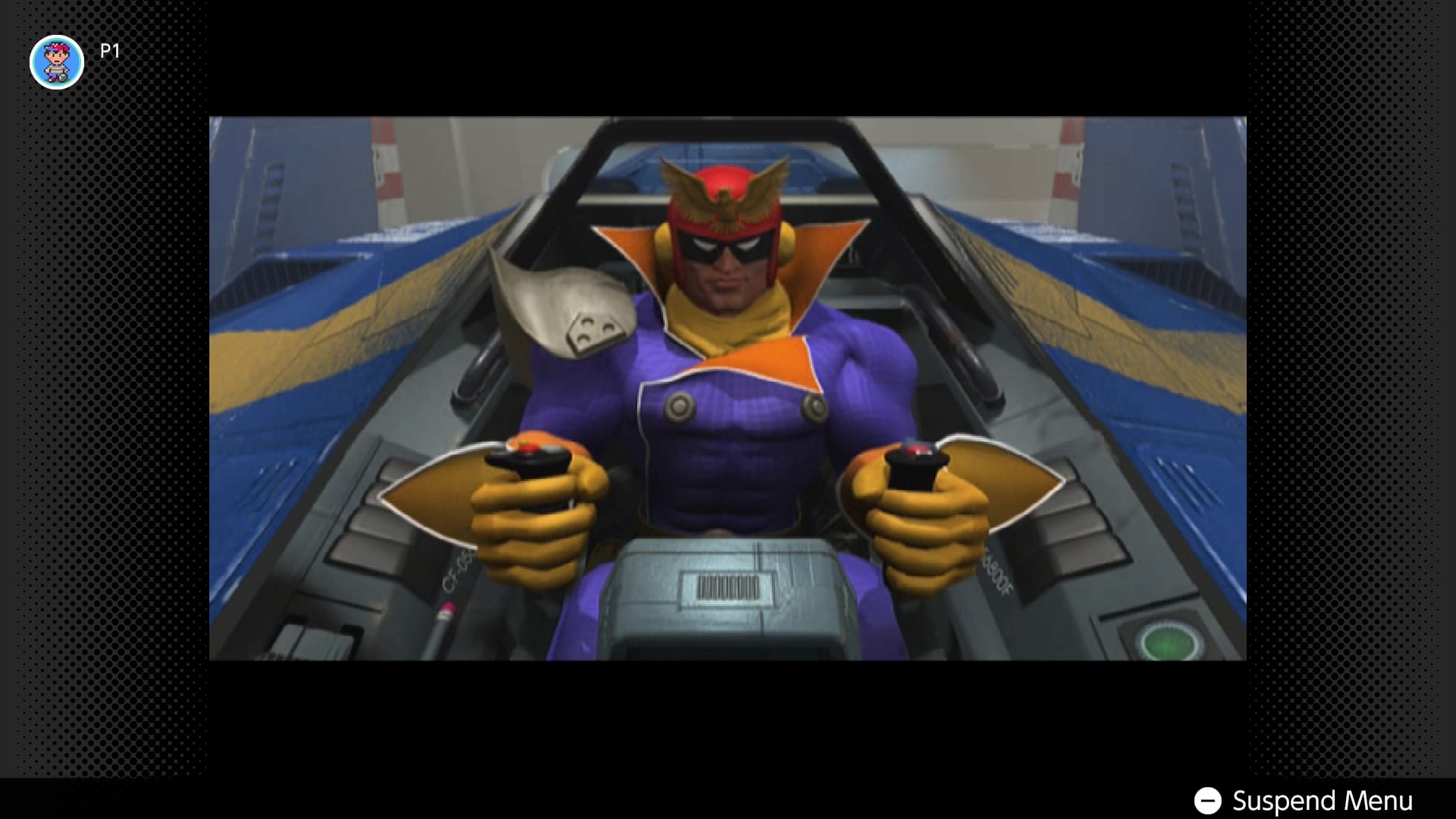
Could a new F-Zero surpass the legacy of F-Zero GX? That the fantastic F-Zero 99 took Captain Falcon out of retirement not even two years ago planted seeds of hope, but the true test lies in the realm of 3D. Dedicated fans contend that even with all the advances in the modern racing game, none have matched its sheer sense of white-knuckled thrills, and I’m inclined to agree – emulation kinks and all. With Nintendo’s revived interest, all it may take for a sequel is fandom noise louder than a G-Diffuser engine.
